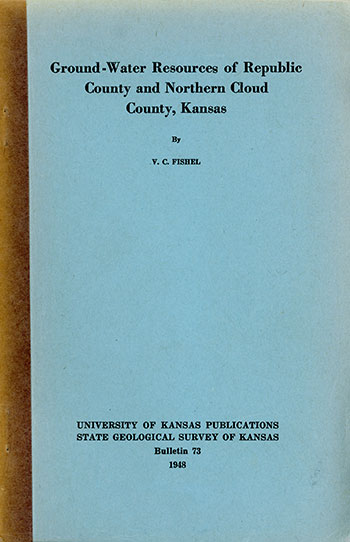Ground-water Resources of Republic County and Northern Cloud County, Kansas
by V. C. Fishel
with chapters on the Quaternary geology and Cenozoic geologic history by S. W. Lohman
and analyses by H. A. Stoltenberg

Originally published in 1948 as Kansas Geological Survey Bulletin 73. This is, in general, the original text as published. The information has not been updated. An Acrobat PDF version (18 MB) is also available; plates available separately.
Abstract
This report describes the geography, geology, and ground-water resources of Republic County and northern Cloud County in north-central Kansas. The area embraces a total of 25 townships, or 899 square miles. The area is drained by the Republican River and its tributaries. The climate is subhumid, the average annual precipitation being about 26 inches. Wheat farming, cattle raising, and general farming are the principal occupations in the area.
The rocks exposed in Republic County and northern Cloud County are of Cretaceous and Quaternary age. The areal distribution of the formations is shown in Plate 1. The oldest formation cropping out in the area is the Dakota formation of Cretaceous age, which is exposed in the southeastern part of Republic County and in northern Cloud County. The overlying Graneros shale and Greenhorn limestone of Cretaceous age are best. exposed in the eastern and southern parts of Republic County along the edges of the streams where the overlying Carlile shale has been eroded away. The Carlile shale mantles the upland areas in the west-central, central, and eastern parts of Republic County. The Pleistocene deposits, which include the Belleville formation, and the loess deposits, comprise the surface materials in a large area in northern Republic County. The soils and alluvium are the youngest deposits in the area.
Test drilling revealed that the ancestral Republican River channel entered Republic County 5 miles south of the Nebraska State line, crossed the present channel near Republic City, and entered Nebraska near Chester.
The report contains a map showing by contours the shape and slope of the water table in the Republican River Valley and in the ancestral Republican River Valley. The map shows that ground water moves into the Republican Valley from both sides. The depth to the water table ranges from less than 10 feet in the Republican Valley to more than 100 feet in the upland in northern Republic County.
The ground-water reservoir is recharged principally by precipitation that falls within the area, by the addition of water from Republican River, and by underflow from adjacent areas. Water is discharged from the ground-water reservoir by seepage into Republican River, by underflow eastward and southward into adjacent areas, by transpiration and evaporation in areas of shallow water table, and by wells. All of the domestic, stock, and public water supplies and a part of the irrigation water supplies are obtained from wells.
Most of the domestic and stock wells in the Republican Valley are driven. Most of the wells on the upland are drilled or bored. The use of ground water for irrigation has barely started. At the time of the field investigation there were only four active irrigation wells in the Republican River Valley in Cloud and Republic counties. Five other wells formerly were used for irrigation.
The ground water in the alluvium and the Belleville formation is hard but it is generally suitable for most ordinary uses. In local areas in northern Cloud County it is highly mineralized. Waters from the Dakota formation in the outcrop areas are relatively soft but they are generally highly mineralized in other areas.
The field data upon which most of this report is based are given in tables, and include records of 291 wells and chemical analyses of the water from 58 wells. Logs of 126 test holes are also given.
Kansas Geological Survey, Geohydrology
Placed on web Nov. 8, 2016; originally published May 1948.
Comments to webadmin@kgs.ku.edu
The URL for this page is http://www.kgs.ku.edu/Publications/Bulletins/73/index.html